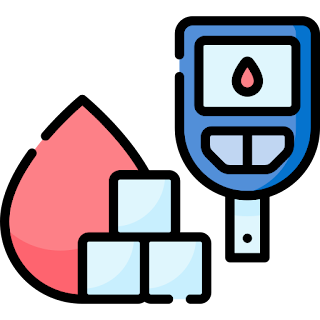Understanding Diabetes: Symptoms, Diagnosis, and Management
Diabetes is a chronic condition characterized by high levels of glucose (sugar) in the blood. It occurs when the body either doesn't produce enough insulin or can't effectively use the insulin it produces. Insulin is a hormone produced by the pancreas that regulates blood sugar levels and allows glucose to enter cells, where it's used for energy. Without enough insulin or when cells become resistant to insulin, glucose builds up in the bloodstream, leading to various health complications. In this blog post, we'll delve into the diagnosis of diabetes, including its symptoms, types, and management strategies.
Symptoms of Diabetes:
The symptoms of diabetes can vary depending on the type and severity of the condition. However, common symptoms include:
Frequent urination: Excess glucose in the bloodstream leads to increased urination as the body tries to remove the excess sugar through urine.
Increased thirst: Excessive urination can lead to dehydration, causing increased thirst.
Unexplained weight loss: Despite eating more than usual, individuals with diabetes may experience unexplained weight loss due to the body's inability to use glucose for energy.
Fatigue: When cells don't receive enough glucose, they lack energy, leading to fatigue and weakness.
Blurry vision: High blood sugar levels can cause fluid to be pulled from the lenses of the eyes, affecting focus and leading to blurry vision.
Slow healing of wounds: Diabetes can impair the body's ability to heal wounds and injuries due to poor circulation and weakened immune function.
Increased hunger: Despite eating, individuals with diabetes may still feel hungry due to the body's inability to properly utilize glucose.
Types of Diabetes:
There are several types of diabetes, with the most common being Type 1, Type 2, and gestational diabetes.
Type 1 Diabetes: This type of diabetes occurs when the immune system mistakenly attacks and destroys insulin-producing cells in the pancreas. It's usually diagnosed in children and young adults, although it can develop at any age. Individuals with Type 1 diabetes require insulin injections to manage their blood sugar levels.
Type 2 Diabetes: Type 2 diabetes occurs when the body becomes resistant to insulin or doesn't produce enough insulin to maintain normal blood sugar levels. It's often associated with lifestyle factors such as obesity, lack of physical activity, and poor diet. Type 2 diabetes can sometimes be managed through lifestyle changes such as diet and exercise, although medication or insulin therapy may be necessary in some cases.
Gestational Diabetes: This type of diabetes occurs during pregnancy when the body can't produce enough insulin to meet the increased needs of pregnancy. It usually resolves after giving birth, but women who have had gestational diabetes are at higher risk of developing Type 2 diabetes later in life.
Diagnosis of Diabetes:
Diagnosing diabetes typically involves one or more of the following tests:
Fasting Plasma Glucose Test: This test measures blood sugar levels after fasting for at least eight hours. A fasting blood sugar level of 126 milligrams per deciliter (mg/dL) or higher indicates diabetes.
Oral Glucose Tolerance Test (OGTT): This test measures blood sugar levels before and two hours after drinking a sugary solution. A blood sugar level of 200 mg/dL or higher after two hours indicates diabetes.
Hemoglobin A1c Test: This test measures the average blood sugar levels over the past two to three months. A hemoglobin A1c level of 6.5% or higher indicates diabetes.
Random Blood Sugar Test: A blood sample taken at any time, regardless of when the person last ate. A blood sugar level of 200 mg/dL or higher indicates diabetes.
Management of Diabetes:
Managing diabetes involves maintaining blood sugar levels within a target range to prevent complications. This typically includes:
Healthy Eating: Following a balanced diet rich in fruits, vegetables, whole grains, lean proteins, and healthy fats can help control blood sugar levels.
Regular Exercise: Physical activity helps lower blood sugar levels by increasing insulin sensitivity. Aim for at least 150 minutes of moderate-intensity exercise per week.
Medication: Depending on the type and severity of diabetes, medication such as insulin injections, oral medications, or other injectable drugs may be necessary to control blood sugar levels.
Monitoring Blood Sugar Levels: Regularly monitoring blood sugar levels allows individuals to adjust their treatment plan as needed to maintain optimal control.
Lifestyle Changes: Quitting smoking, managing stress, and getting adequate sleep can all help improve overall health and reduce the risk of complications associated with diabetes.
In conclusion, diabetes is a complex condition that requires lifelong management to prevent complications and maintain quality of life. By understanding the symptoms, types, and diagnosis of diabetes, individuals can work with healthcare professionals to develop a personalized treatment plan that meets their needs and helps them live well with diabetes. If you or someone you know is experiencing symptoms of diabetes, it's important to seek medical attention for proper evaluation and diagnosis.
#DiabetesAwareness
#Type1Diabetes
#Type2Diabetes
#BloodSugarControl
#HealthyLiving
#InsulinManagement
#GestationalDiabetes
#DiabetesPrevention
#LivingWithDiabetes
#HealthEducation




Comments
Post a Comment